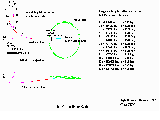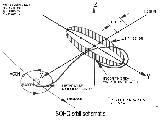
 |
SOHO Commisioning Phase |
 Weekly Operations Schedule
Weekly Operations Schedule


![[NEW]](/gif/new.gif)
The SOHO transfer and halo orbits.
During this transfer phase the focus of the mission operations will be to check out all the spacecraft subsystems including the payload. The sequence and the timing of events in this phase has been carefully planned and is documented in the SOHO Commissioning Plan. A description of the planned operations, and the related timelines can be accessed from this page, and a summary is given here.
The SOHO Service Module (SVM) will verify its basic subsystems as soon as possible after launch, and will conduct further tests in relation to maneuvers and other special events in the transfer trajectory phase.
The detailed operations and scheduling constraints per block are
written up in block sheets and are grouped here together with the
detailed timelines per experiment, and for the
SVM.
Joint Operations
In addition to the individual check-outs there are several commissioning
tests that involve more than one of the experiments and/or the SVM.
These tests have been discussed by the SOWG and a coordinator has been selected
to assemble all the information needed and draw a plan:
![[NEW]](/gif/updated.gif) J3 Script (April 2, 21:00 UT)
J3 Script (April 2, 21:00 UT)
Finally there is a schedule of intercalibrations between experiments, planned by the Intercalibrations Working Group (ICWG), chaired by John Kohl.
For the detailed planning of operations the following ground-rules have been established:
A definition of the phases of the commissioning plan is given in the table below, and the timeline (when available) for each phase can be inspected by clicking on the entry. Even more detailed timelines per experiment and for the SVM can be found here.
NOTE: All the files are in PostScript format.
DSN provides us with three different schedules, in increasing order of accuracy:
The daily schedules for the upcoming weeks reflect in their timing the latest DSN information, but longer term schedules obviously cannot. In the latter a start of the long contact at noon (12:00 PM) GMT has been assumed, because clock time then coincides with elapsed time since the beginning of the contact.
 Return to the Science Operations page
Return to the Science Operations page